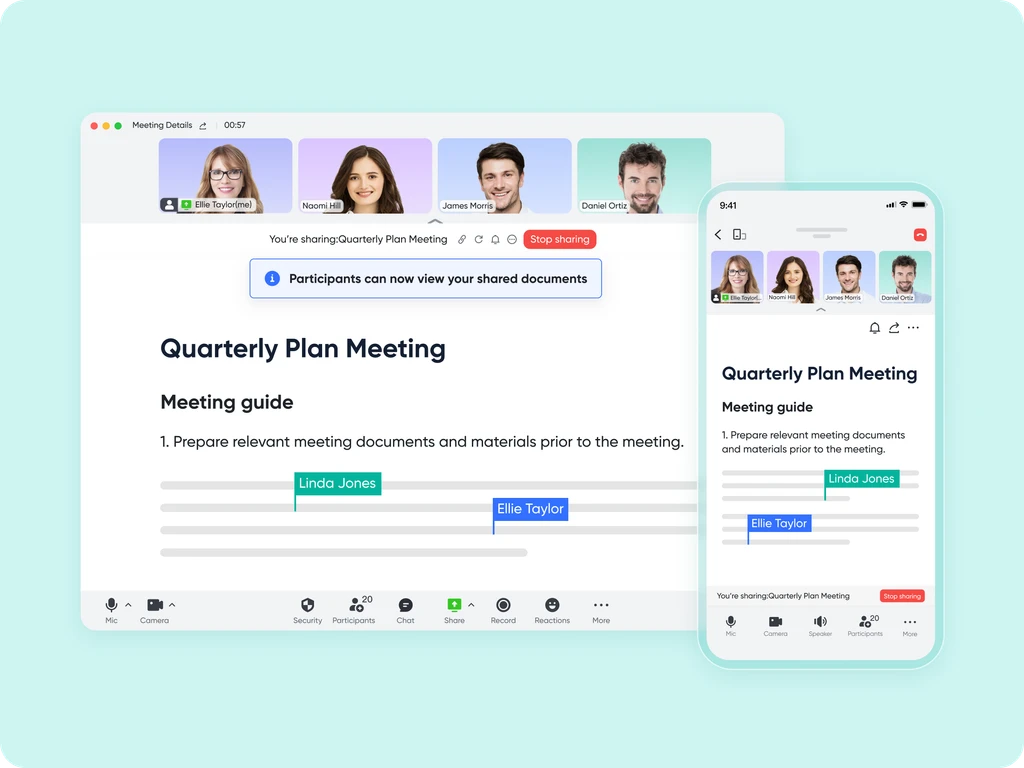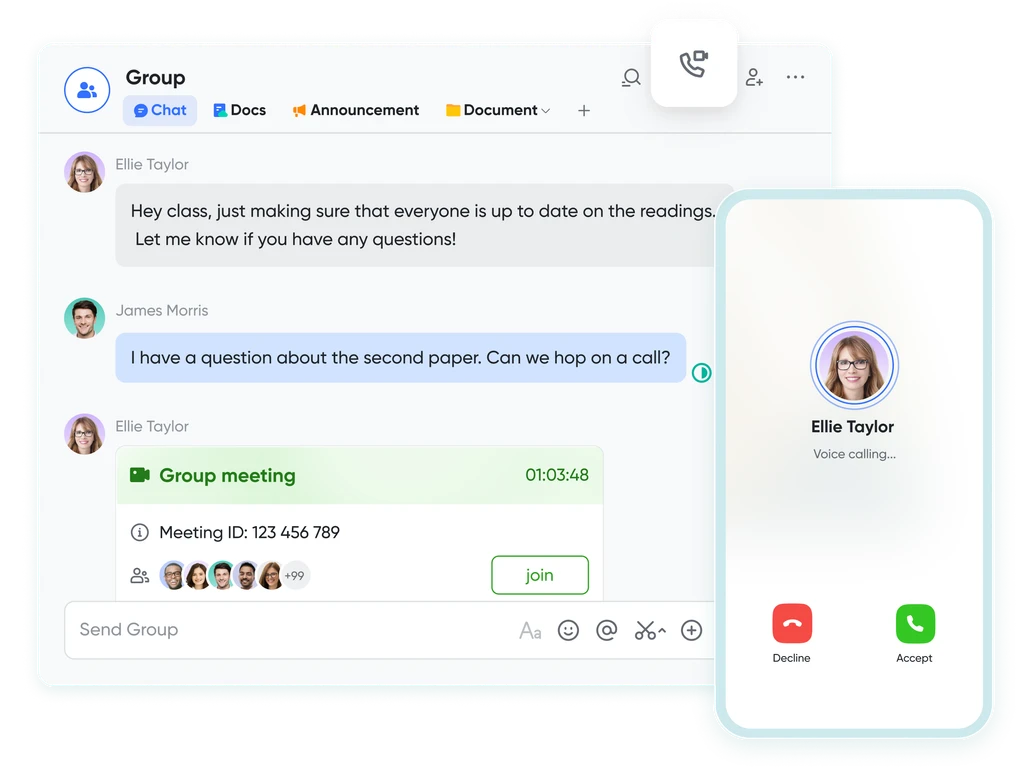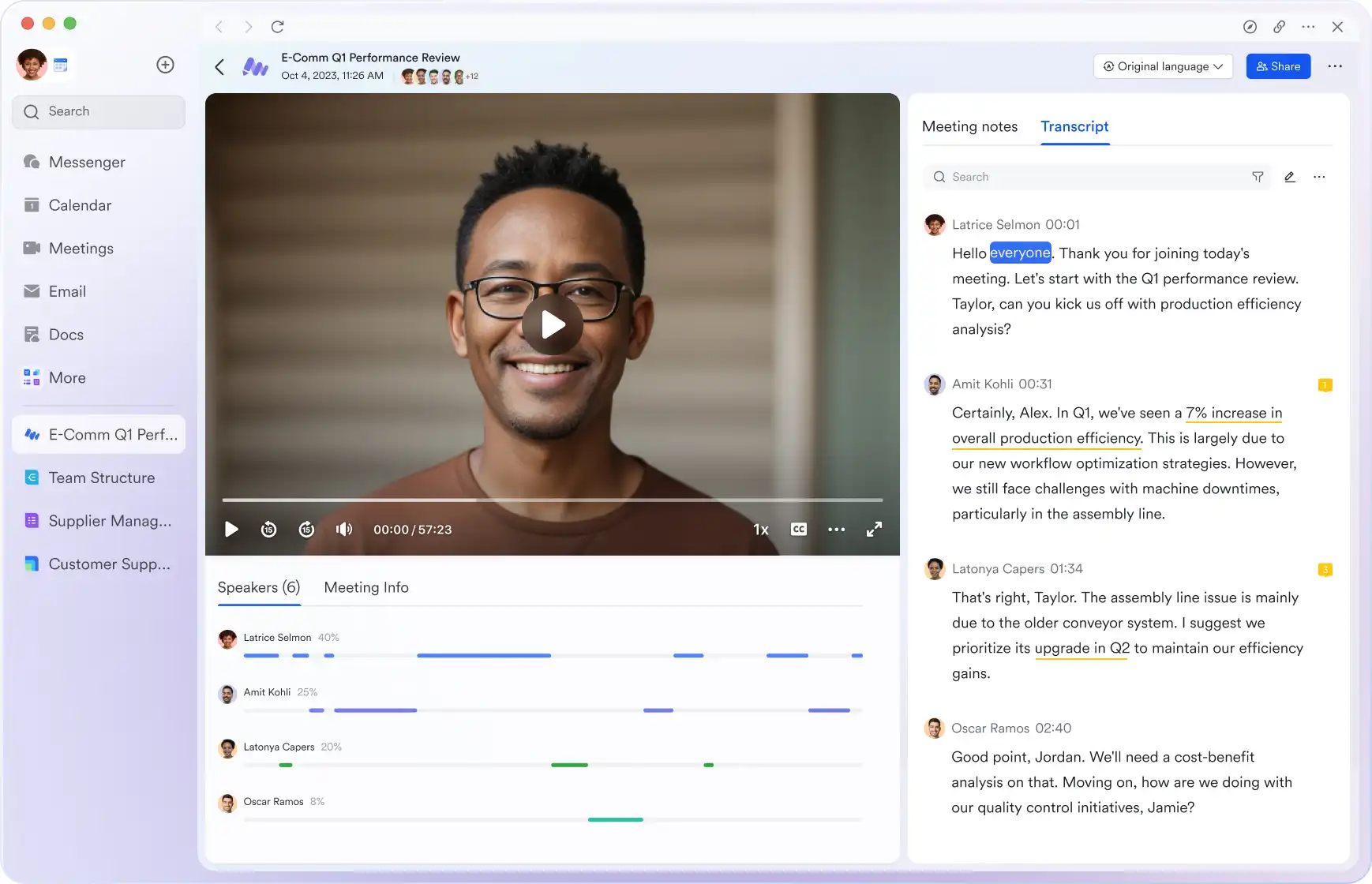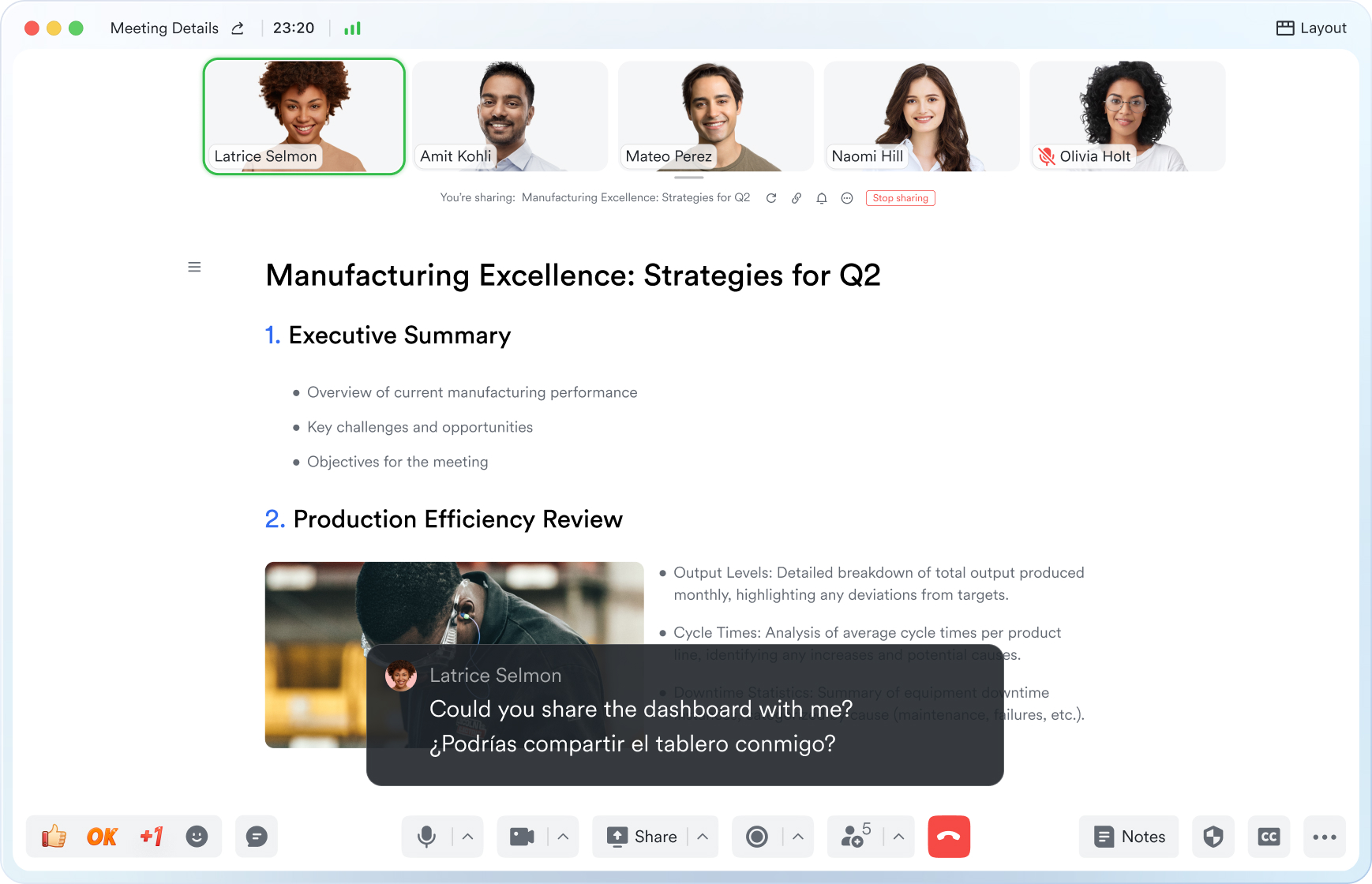Townhall Meeting
This guide will walk you through the essential elements of use townhall meeting to keep your attendees aligned and engaged.
Try Lark for Free
In the ever-evolving landscape of 2024, effective communication within organizations has never been more critical. Town hall meetings, as a cornerstone of internal communication, play a pivotal role in fostering transparency, engagement, and alignment. In this comprehensive guide, we will delve into the intricacies of conducting a successful town hall meeting. Whether you're an experienced leader or a newcomer to town hall meetings, this article will provide you with the knowledge and strategies needed for success in 2024.
Use Lark Meetings to turn meetings into true collaborative experiences.
What is a town hall meeting?
Understanding Town Hall Meetings
Town hall meetings are interactive gatherings where leaders and employees come together to discuss company updates, share information, and engage in open dialogue. These meetings are instrumental in promoting transparency and ensuring that everyone within the organization is well-informed.
Goals of a town hall meeting
Fostering Transparency and Engagement
The primary goals of a town hall meeting include:
- Transparency: Sharing company updates, successes, and challenges openly.
- Engagement: Encouraging employees to participate actively and share their perspectives.
Who should attend a town hall meeting?
Key Participants
For a successful town hall meeting, it's essential to have the right participants present:
- Leadership Team: Including executives and senior management.
- Employees: All members of the organization, regardless of their role, should be encouraged to attend.
- Stakeholders: Depending on the nature of the meeting, stakeholders such as investors or partners may also be invited.
Related:
Unlock the Power of Webinars: A Comprehensive Guide to Boost Your Business | Lark Blog | Lark BlogLearn more about Lark x Meetings
Topics, agenda, and structure of a town hall meeting
Structuring the Meeting
A well-structured town hall meeting typically includes the following key components:
- Welcome and Introduction: Opening remarks by the CEO or a senior leader.
- Company Updates: Sharing recent achievements, financial performance, and strategic goals.
- Q&A Session: Allowing employees to ask questions and provide feedback.
- Recognition and Appreciation: Acknowledging outstanding employee contributions.
- Future Plans: Discussing upcoming initiatives and organizational direction.
- Closing Remarks: Summarizing key takeaways and expressing gratitude.
How to host a town hall meeting?
Step-by-Step Guide
Hosting a successful town hall meeting involves careful planning and execution. Follow these steps for a well-organized event:
- Preparation: Set clear objectives, create an agenda, and gather relevant data and updates.
- Communication: Promote the meeting well in advance, using various channels.
- Engagement: Encourage employees to submit questions or topics they'd like to address during the meeting.
- Facilitation: Designate a skilled facilitator to guide the meeting and maintain a positive atmosphere.
- Feedback: Collect and address questions and feedback from employees, both before and during the meeting.
- Accessibility: Ensure that remote or geographically dispersed employees can participate through virtual conferencing tools.
Learn more about Lark x Meetings
How often does a town hall meeting occur?
Meeting Frequency
The frequency of town hall meetings can vary depending on the organization's needs and goals:
- Quarterly: Many organizations opt for quarterly town hall meetings to align with financial reporting periods.
- Monthly or Bi-Monthly: Some organizations choose more frequent meetings for real-time updates.
- Annually: An annual town hall meeting is common for sharing high-level strategic plans.
Key differences between town hall meetings and similar meetings
Understanding Distinctions
Town hall meetings have unique characteristics that distinguish them from other types of gatherings:
- Open Forum: Town hall meetings provide employees with a platform to ask questions and share opinions openly.
- Transparency: These meetings prioritize transparency and candid discussions about the organization's performance.
- Engagement: Leaders actively seek employee engagement and input in decision-making processes.
Learn more about Lark x Meetings
Common pitfalls of town hall meetings
Avoiding Mistakes
To ensure the success of your town hall meetings, steer clear of these common pitfalls:
- Lack of Preparation: Failing to prepare adequately can lead to disorganized and unproductive meetings.
- Ignoring Employee Feedback: Neglecting employee questions or concerns can erode trust.
- Monologues: Avoid turning the meeting into a one-way communication channel dominated by leadership.
- Overly Optimistic Messaging: Balancing optimism with realism is crucial to maintaining credibility.
Factors for a successful virtual town hall meeting
Embracing Virtual Communication
In the digital age of 2024, virtual town hall meetings have become a necessity. Consider these factors for hosting a successful virtual town hall meeting:
- Technology: Utilize reliable virtual conferencing tools to ensure seamless communication.
- Interactivity: Incorporate interactive elements like polls and chat for remote participants.
- Accessibility: Ensure that remote employees have access to meeting recordings for later viewing.
Learn more about Lark x Meetings
Typical takeaways from a town hall meeting
Measuring Success
Successful town hall meetings result in tangible takeaways:
- Informed Workforce: Employees leave the meeting with a better understanding of the organization's direction and performance.
- Employee Engagement: Encouraging employees to actively participate and share their thoughts.
- Alignment: Ensuring that all employees are aligned with the company's vision and goals.
Questions to ask in a town hall meeting
Fostering Meaningful Discussions
To drive meaningful discussions during a town hall meeting, consider asking these questions:
- **What are the key achievements and milestones the company has reached since the last meeting?
- **What challenges or obstacles are currently facing the organization, and how can employees contribute to overcoming them?
- **What initiatives or changes can employees expect in the coming months, and how will these impact their roles?
- **What opportunities for improvement does the organization see, and how can employees play a part in realizing them?
- **How can employees continue to provide feedback and stay informed between town hall meetings?
Learn more about Lark x Meetings
Tools to enhance town hall meetings
Leveraging Collaborative Tools
Consider incorporating tools like Lark to enhance your town hall meetings:
- Announcement Feature: Use Lark's announcement feature to notify employees about upcoming town hall meetings and share key updates.
- Video Conferencing: Host virtual town hall meetings on Lark, allowing remote employees to participate seamlessly.
- Q&A Chat: Enable the Q&A chat feature to collect and address employee questions in real-time.
Examples: real-world scenarios
Scenario 1: tech company town hall meeting
Scenario 1: tech company town hall meeting
Brief Content: In a town hall meeting at a tech company, the CEO shared the latest product innovations, financial results, and plans for expansion. Employees asked questions about the company's vision and opportunities for professional growth.
Detailed Content: The CEO opened the meeting by highlighting recent product launches and their impact on the market. Financial results were shared transparently, with a focus on growth and profitability. During the Q&A session, employees asked about the company's long-term vision and received insights into the organization's strategic direction.
Scenario 2: healthcare organization town hall meeting
Scenario 2: healthcare organization town hall meeting
Brief Content: A healthcare organization held a virtual town hall meeting to discuss patient care improvements and the challenges posed by the changing healthcare landscape. Employees in various locations participated and discussed telemedicine initiatives.
Detailed Content: The meeting began with a discussion of patient care initiatives and improvements in healthcare delivery. Leaders addressed the impact of telemedicine on the organization and
opportunities for employees to contribute. The virtual format allowed employees from different locations to actively participate and share their perspectives on patient care innovations.
Scenario 3: nonprofit organization town hall meeting
Scenario 3: nonprofit organization town hall meeting
Brief Content: A nonprofit organization hosted an annual town hall meeting to update employees and volunteers on fundraising efforts, program successes, and future plans. Attendees asked about volunteer opportunities and fundraising strategies.
Detailed Content: The meeting included an overview of fundraising achievements and the impact on the organization's programs. Leaders discussed opportunities for employees and volunteers to get involved and make a difference. Attendees asked questions about specific volunteer roles and fundraising strategies, leading to collaborative discussions.
Related:
Unlock the Power of Webinars: A Comprehensive Guide to Boost Your Business | Lark Blog | Lark BlogLearn more about Lark x Meetings
Tips for do's and don'ts
Best Practices and Pitfalls to Avoid
Follow these do's and don'ts to ensure productive and effective town hall meetings:
| Do's | Don'ts |
|---|---|
| Prepare a well-structured agenda in advance. | Don't underestimate the importance of preparation. |
| Encourage open and honest communication. | Avoid monopolizing the conversation. |
| Actively listen to employee feedback. | Don't dismiss employee concerns or questions. |
| Address questions and concerns transparently. | Avoid making unrealistic promises. |
| Express appreciation for employee contributions. | Don't neglect recognition and appreciation. |
Learn more about Lark x Meetings
Conclusion
In the dynamic landscape of 2024, town hall meetings remain a vital tool for organizations to communicate, engage, and align their teams. By following the principles outlined in this guide, you can successfully plan and conduct town hall meetings that foster transparency, engagement, and collaboration. Whether in person or virtually, town hall meetings serve as a cornerstone of internal communication, driving organizational success and employee satisfaction.
Use Lark Meetings to turn meetings into true collaborative experiences.
A Game Changer for Townhall Meeting: Empower your team with Lark Meetings
In the fast-paced and dynamic world of modern business, effective communication and collaboration are crucial for success of Townhall Meeting. Here we introduce Lark Meetings to serve as a centralized hub for all communication needs.
Transform your meetings into collaborative endeavors

Leverage the potency of in-call document sharing, intelligent meeting minutes, and mobile-optimized features to enhance productivity collaboratively, irrespective of your location or schedule.
Seamlessly collaborate in real-time, across any device

Share live documents instead of just screen views. Participants can navigate and edit simultaneously within the video call window, even while on the move.
Shift your focus to engagement, not note-taking

Lark Minutes automatically converts video meetings into transcripts, facilitating easy viewing, searching, and collaborative editing. Stay in the loop asynchronously, even if you can't attend the live meeting. Lark Minutes for meeting minutes support translation into 10+ different languages.
Break language barriers in communication

Lark Meetings provide real-time translation for subtitles, allowing individuals from diverse backgrounds to express themselves in their native languages. Ensure every voice is heard, regardless of geographical location. Live subtitles currently support translations from English, Chinese, and Japanese to 10+ different languages. See more translation feature in Lark.
Connect with larger audiences
Host dynamic online meetings and events accommodating up to 1,000 participants, with the flexibility of up to 50 breakout sessions for intimate group discussions within the larger meeting context. Try more Lark features for free.








